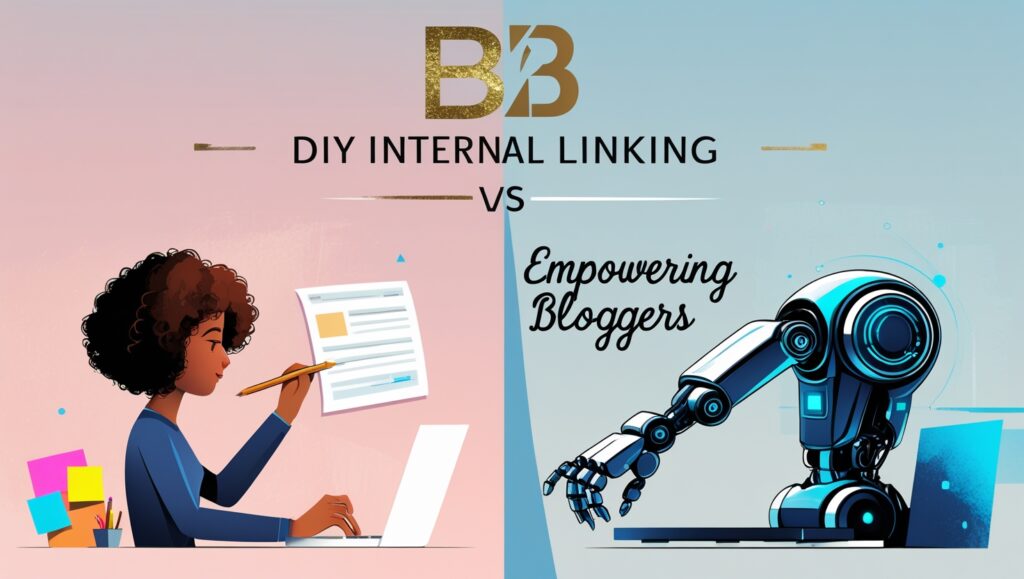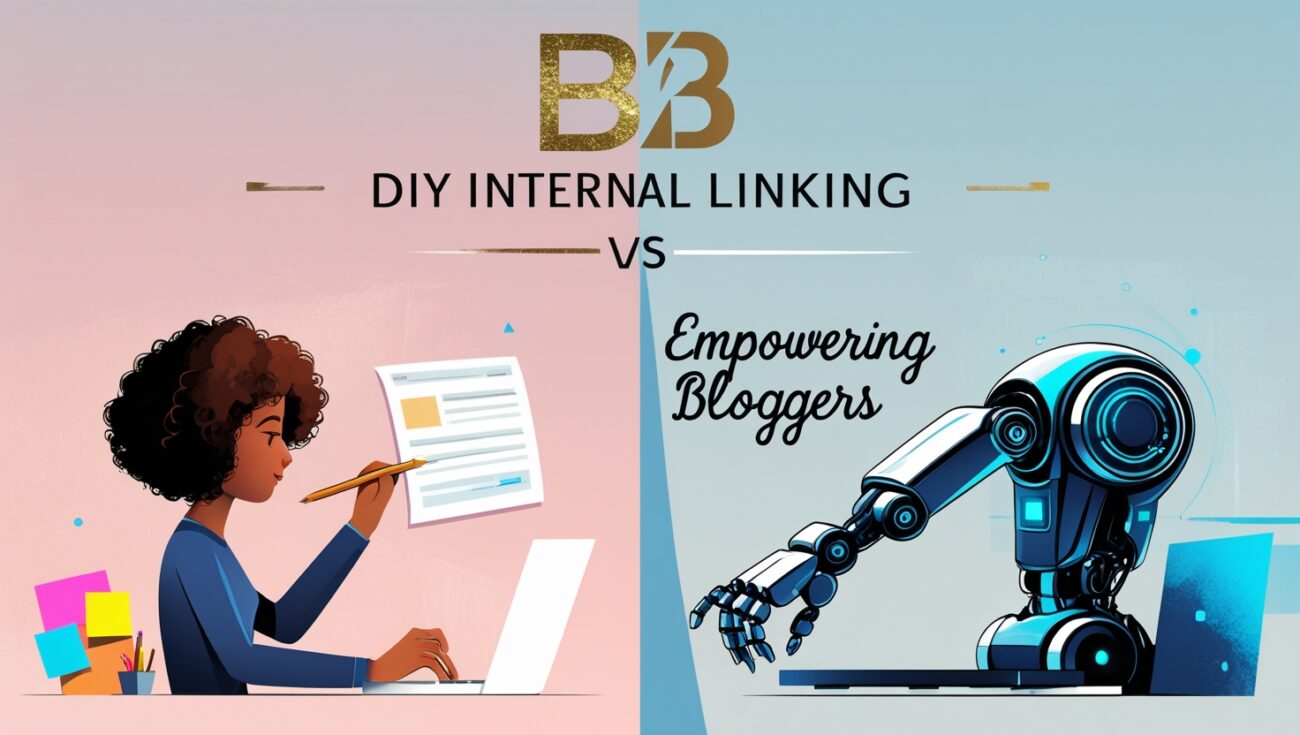DIY Internal Linking vs. Automation: What’s Best for Your Blog?
As a blogger deeply involved in the world of SEO, I often get asked about the best strategies for improving website rankings. While external backlinks get a lot of the spotlight, internal linking is a foundational element that’s entirely within your control. The big question for many bloggers is: should you tackle internal linking with a do-it-yourself (DIY) approach, or is it better to leverage the power of automation?
Both DIY and automation have their pros and cons. The “best” approach often depends on the size and complexity of your blog, your technical skills, and the amount of time you have available. Let’s dive into a detailed comparison to help you decide what’s the right fit for you.

Table of Contents
DIY Internal Linking: The Hands-On Approach
The DIY method involves manually identifying linking opportunities within your existing content and adding those links yourself. This might involve revisiting old blog posts when you publish new ones, or consciously thinking about relevant connections as you write.
How Internal Linking Automation Simplifies SEO
When I first started optimizing my site, adding links manually felt endless. That’s when I discovered internal linking automation, and it completely changed the way I manage content. Instead of hunting for related posts and manually creating links, I now rely on Linkbot — the smartest tool I’ve found for automated internal linking.
It scans my pages, finds relevant connections, and adds them automatically — all while keeping the context natural. The best part is that automation doesn’t just save me time; it actually strengthens my SEO. Every internal link helps Google understand the relationships between my articles, boosting topic relevance and improving crawl depth.
With internal linking automation, I can publish freely knowing my content stays well connected. And with Linkbot, it feels like having an invisible SEO assistant working behind the scenes 24/7 — keeping my site perfectly linked, structured, and ready to rank.
| Feature | Description |
| Control | Full control over anchor text and link placement. |
| Cost | Generally free (your time is the main cost). |
| Learning Curve | Relatively low to understand the basic principles. |
| Scalability | Becomes increasingly difficult and time-consuming as your blog grows. |
| Efficiency | Can be very inefficient for larger blogs. |
| Accuracy | Relies on your memory and understanding of your content. Prone to oversight. |
Export to Sheets
Pros of DIY Internal Linking:
- Complete Control: You have the final say on every link, ensuring it fits perfectly within the context and uses your preferred anchor text.
- Cost-Effective (Initially): The only direct cost is your time, which can be manageable for new or small blogs.
- Deep Content Understanding: The process forces you to revisit and understand the connections between your content.
Cons of DIY Internal Linking:
- Time-Consuming: Identifying linking opportunities and manually adding links can take up a significant amount of your valuable time.
- Scalability Issues: As your blog grows, the effort required to maintain a comprehensive internal link network becomes exponentially harder. If you’re looking for a better solution, you can start exploring the benefits of automation with Linkbot.
- Risk of Oversight: It’s easy to miss relevant linking opportunities, especially on older or less familiar content.
- Anchor Text Inconsistency: You might inadvertently use inconsistent anchor text or over-optimize certain keywords.
- Maintenance Challenges: Finding and fixing broken internal links can become a tedious manual process.
Automated Internal Linking: Leveraging Technology
Automated internal linking software uses algorithms and AI to analyze your website’s content and structure, identifying relevant linking opportunities and often assisting with the link insertion process.
| Feature | Description |
| Control | Varies by tool; often offers control over rules and suggestions. |
| Cost | Requires an investment in the software (monthly or one-time fee). |
| Learning Curve | Varies by tool; some are very intuitive, others have more advanced features. |
| Scalability | Highly scalable; can handle websites of any size efficiently. |
| Efficiency | Significantly more efficient than manual linking, saving you considerable time. |
| Accuracy | Relies on algorithms but often provides highly relevant suggestions. |
Export to Sheets
Pros of Automated Internal Linking:
- Significant Time Savings: The software handles the heavy lifting of identifying and suggesting links, freeing up your time for content creation.
- Improved Scalability: Easily manage internal links on blogs of any size, even those with thousands of pages.
- Reduced Risk of Oversight: Algorithms can identify linking opportunities you might have missed. If you’re ready to make the jump, check out Linkbot’s powerful features here.
- Consistent Anchor Text Suggestions: Many tools help you vary your anchor text naturally.
- Easy Identification of Orphaned Pages: These tools can quickly pinpoint pages with no internal links.
- Streamlined Link Maintenance: Some tools offer features to find and fix broken internal links.
- Enhanced Link Equity Flow: Automation helps ensure that link authority is distributed effectively across your site.
Cons of Automated Internal Linking:
- Cost: Requires a financial investment in the software.
- Potential for Irrelevant Suggestions: While improving, algorithms might occasionally suggest less relevant links. Requires review.
- Loss of Complete Control: You’re relying on the software’s analysis, although most tools offer varying degrees of control.
- Learning Curve (for advanced features): Some tools have more complex features that might take time to master.
Visualizing the Difference
Imagine your blog as a city.
- DIY Internal Linking: You’re personally building each road, deciding where it goes and what it connects. This works for a small village but becomes chaotic in a sprawling metropolis.
- Automated Internal Linking: You’re using a sophisticated city planning system that analyzes traffic flow and automatically builds the most efficient network of roads, ensuring every district is well-connected.
Which Approach is Right for You?
The decision between DIY and automation isn’t always black and white. Here are some factors to consider:
- Blog Size: For new blogs with under 50 pages, DIY might be manageable. However, for anything larger, automation quickly becomes the more efficient and effective option.
- Time Availability: If you’re short on time and want to focus on content creation, automation is the clear winner. Discover how Linkbot can save you hours of manual work.
- Technical Skills: Most automated tools are user-friendly and don’t require advanced technical knowledge.
- Budget: If you’re on a tight budget, DIY is the initial cost-saver. However, consider the value of your time saved with automation.
- SEO Goals: If you’re serious about maximizing your SEO potential and ensuring a strong site structure, automation provides a significant advantage.
Considering a Hybrid Approach
It’s also worth noting that a hybrid approach can work well. You might start with DIY for your core content and then implement automation as your blog grows or to handle specific tasks like finding orphaned pages or suggesting links across a large archive.
Conclusion: Invest in Efficiency and Growth
While the hands-on control of DIY internal linking can be appealing, for most bloggers looking to scale their website and maximize their SEO efforts, automated internal linking software is the more strategic and efficient choice. It saves you valuable time, reduces the risk of errors, and helps you build a stronger, more interconnected website that both users and search engines will appreciate.
If you’re ready to stop wasting time on manual linking and start focusing on creating more great content, I highly recommend exploring the benefits of automation. You can learn more about how tools like Linkbot can streamline your internal linking strategy and boost your SEO by clicking here. It’s an investment in your blog’s future that will pay off in the long run.

